The works of Botticelli, Michelangelo, Bruneschelli, Leonardo da Vinci, Boccaccio, Alberti, Masaccio, Donatello, Vasari and Fra Angelico imbue the city with the magnificence of their contribution to art and life. The city itself is muse to some and home to many stylish citizens who titivate the cobbled streets and fashionable piazzas with their inimitable Italian flair.
Of course, like many other cities, Florence suffers from too much traffic (although efforts have been made to restrict it from the centre of town), too many tourists, and an historic old centre tainted by cheap-looking fast food restaurants.
The city is undoubtedly expensive – so
pick your hotel and restaurant carefully, and as far away from the main
sights as is practical. But it is those sights that make Florence such
an unforgettable destination.
The chapels, galleries and museums
capture the spirit of the Renaissance more fully than any other city in
Italy: no visitor could fail to be impressed. The 14th-century Ponte Vecchio, or Old Bridge, is still home to many quaint shops selling gold and the place to get a great view of the River Arno at dusk.
But for a view you’ll never forget,
take a bus, or, if you’re feeling fit, walk up to the Piazzale
Michelangelo, perched up on a hill. From here, Florence can be seen in
one splendid panorama, to be permanently imprinted on your heart.
Popular things to do and see in Florence include:
- Galleria degli Uffizi – Justly one of the world’s most famous fine art museums. The collections of Renaissance paintings and sculptures from classical antiquity are superb. Included is The Birth of Venus by Sandro Boticelli. There are often long lines (several hours’ wait is common) starting even before the doors open. The restaurant/caffè has a large balcony overlooking the main piazza with good views of the Palazzo Vecchio. It is a great place to take a break for art lovers making a non-rushed visit to this fantastic collection. This cafe is rather expensive however. Street performers are often seen outside the Uffizi. Admission is around €6.50
- Bargello – This museum houses one of the best examples of Renaissance and Mannerist sculpture. The works of many great Renaissance sculptors are on display here, including Michelangelo, Donatello, Ammannati, Bandinelli, Andrea and Jacopo Sansovino, Desiderio da Settignano, Giambologna, and Antonio Rossellino. The museum is located near Piazza della Signoria and can be seen in a few hours. Admission is around €4.
- Accademia Gallery – Highlights are Michelangelo’s David and the unfinished Slaves. The David was recently cleaned in a controversial project. No photography is allowed inside. Wait times can be under one hour in the off-season.
- Pitti Palace – On the quieter south bank of the Arno. The former Medici family palace contains galleries of their art and treasures. The Boboli gardens behind the palazzo offer wonderful walks and excellent views of the city and the countryside south of the city.
- Museo dell’Opera del Duomo – The Cathedral Museum, with artworks formerly in the Duomo and surrounding religious buildings, including sculptures by Donatello, another version of the Pietà (different from that one of Saint Peter’s Basilica, in Vatican, Rome) by Michelangelo, and the losing entries in the famous contest held in 1401 to design the doors of the Baptistery. Models and drawings of the Cathedral. Worthy. €6 Children under 6 free.
- Institute and Museum of the History of Science – This museum shows the evolution of the instruments used in various scientific fields such as Mathematics, Physics, Biology, Chemistry, Astronomy. The room of Galileo Galilei shows some of his original instruments as well as models from his drawings. The room of Spheres and Globes houses an excellent cartographic collection. In a rather macabre twist the museum also has the middle finger of Galileo’s right hand on display.
- Santa Maria del Fiore – also known as the Duomo di Firenze is the city’s beautiful cathedral, the symbol of the city. Brunelleschi’s huge dome was an engineering feat of the rennaissance. A statue of Brunelleschi is sited in the piazza, with his figure looking upwards towards his dome. It is possible to climb the Dome (entrance on the side of the church), which has 464 steps. €8 entrance fee (June 2010), and usually has a long lineup.
- Giotto’s Tower – adjacent to the Duomo, you can climb the tower for a magnificent 360-degree view of the Duomo, Florence, and the surrounding area.€6 entrance fee, and requires some tenacity to climb 414 steps.
- Baptistery – famous for bronze doors by Andrea Pisano (14th century) and Lorenzo Ghiberti (15th century) and a beautiful interior the vault of which is decorated with 13th century mosaics (the only medieval set of mosaics in the city.
- Palazzo Vecchio – old city palace/city hall, adorned with fine art. The replica of Michelangelo’s “David” is placed outside the main door in the original location of the statue, which is a symbol of the Comune of Florence. The site displays an important collection of Renaissance sculptures and paintings, including the Putto, by Verrochio, and the series of murals by Giorgio Vasari at the Salone dei Cinquecento (Hall of the Five Houndreds) – the hall which used to display the now lost Renaissance masterpiece, that is, the so-called Battaglia di Anghiari, by Leonardo da Vinci.
- Ponte Vecchio – the oldest and most famous bridge over the Arno; the only Florentine bridge to survive WW2. The Ponte Vecchio (literally “old bridge”) is lined with shops, traditionally mostly jewellers since the days of the Medici. Vasari’s elevated walkway crosses the Arno over the Ponte Vecchio, connecting the Uffizi to the old Medici palace.
- Santa Croce – church contains the monumental tombs of Galileo, Michelangelo, Machiavelli, Dante, and many other notables in addition to artistic decorations. There is also great artwork in the church. And when you’re done seeing that, a separate charge will gain you admission to the Museo dell’Opera di Santa Croce, where you can see a flood-damaged but still beautiful Crucifix by Cimabue (Giotto’s teacher), which has become both the symbol of the flooding of Firenze in 1966 and of its recovery from that disaster. The Pazzi Chapel, a perfectly symmetrical example of sublime neo-Classic Renaissance architecture is also worth visiting.
- Santa Maria Novella – near the train station, is a beautiful church and contains great artwork, including a recently restored Trinity by Masaccio. Also, the Chiostro Verde, to your left when facing the front entrance of the church, contains frescoes by Paolo Uccello which are quite unusual in style and well worth seeing, if the separate entrance is open. Off of the church’s cloister is the wonderful Spanish Chapel which is covered in early Renaissance frescoes.
- Orsanmichele – a beautiful old church from the 14th century, which once functioned as a grain market
- San Lorenzo – the facade of this church was never completed, giving it a striking, rustic appearance. Inside the church is pure Renaissance neo-classical splendor. If you go around the back of the church, there is a separate entrance to the Medici chapels. Be sure to check out the stunning burial chapel of the princes and the sacristy down the corridor. The small sacristy is blessed with the presence of nine Michelangelo sculptures.
- San Marco Convent – (1436) houses frescoes by Fra Angelico and his workshop. Fra Angelico painted a series of frescoes for the cells in which the Dominican monks lived.
- Boboli Gardens – elaborately landscaped and with many interesting sculptures, behind the Pitti Palace. Wonderful city views. Don’t miss the Bardini gardens. Entrance to that is included in the combination ticket price for the Boboli, and it’s a short walk from the Boboli Gardens. There are great views of the Duomo from the Bardini gardens. A single adult ticket to the gardens costs €7.
- Santa Maria del Carmine – has famous frescoes (Masaccio’s Adam and Eve Banished From the Garden and others by Lippi and Masolino) in the Brancacci Chapel.
- Piazzale Michelangelo – (Michelangelo square) plaza on a hilltop with a great view of the city (go there by bus) or climb the stairs and paths from the Lungarno della Zecca.
- San Miniato al Monte – uphill from Piazzale Michelangelo. The Sacristy contains frescoes by Spinello Aretino. In the cemetery near this church there are graves of famous people of Florence, including Carlo Lorenzi (Collodi) – author of the famous Pinocchio.
- Santa Felicita – on the Oltrarno, or south side of the Ponte Vecchio, contains frescoes of the Annunciation and a painting of the Deposition of Christ by the brilliant and weird mannerist painter, Pontormo. They are to be found in the Barbadori Chapel, which is to your immediate right when entering the church.


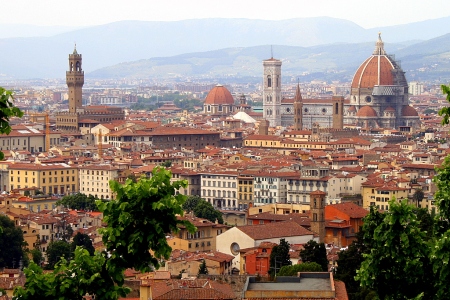
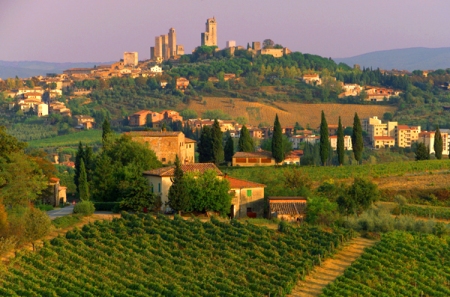
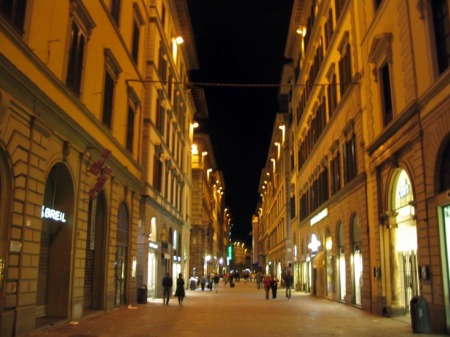
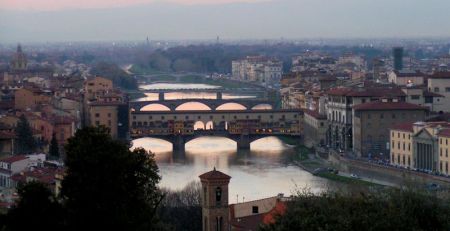
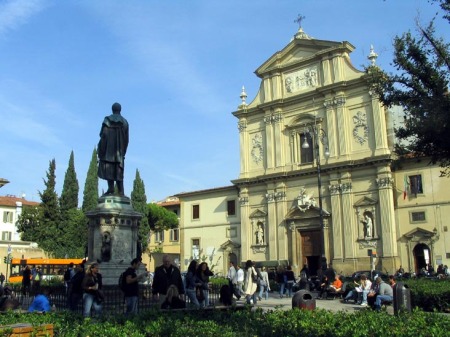



3 comments:
prety city
prety city
Nice blog, it reminds me of the panorama of Florence from Piazza Michelangelo , the best place to watch over Florence anytime of the day.I tried to write a blog about it in http://stenote.blogspot.com/2018/01/florence-view-from-piazzale-michelangelo.html
Đăng nhận xét